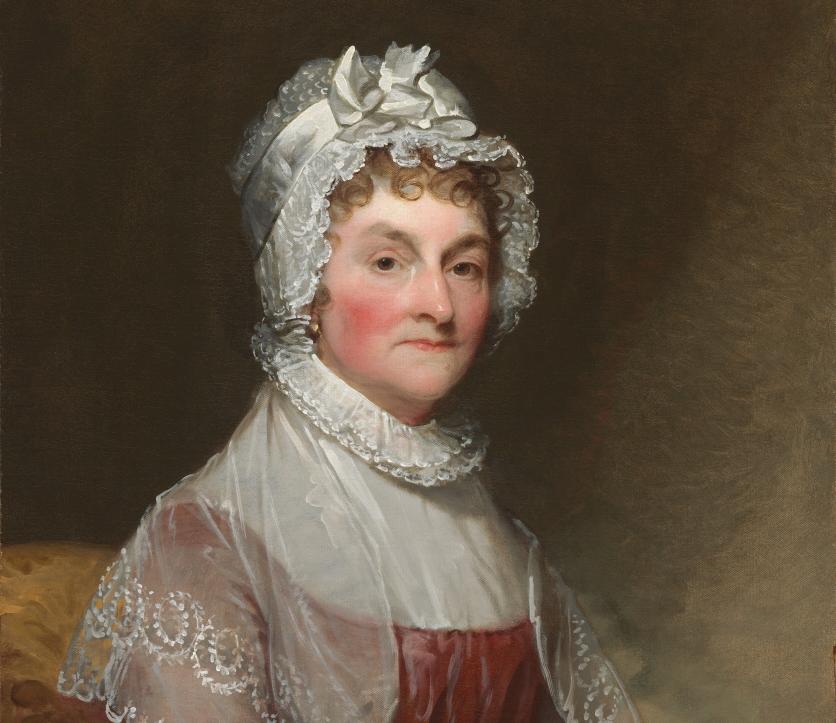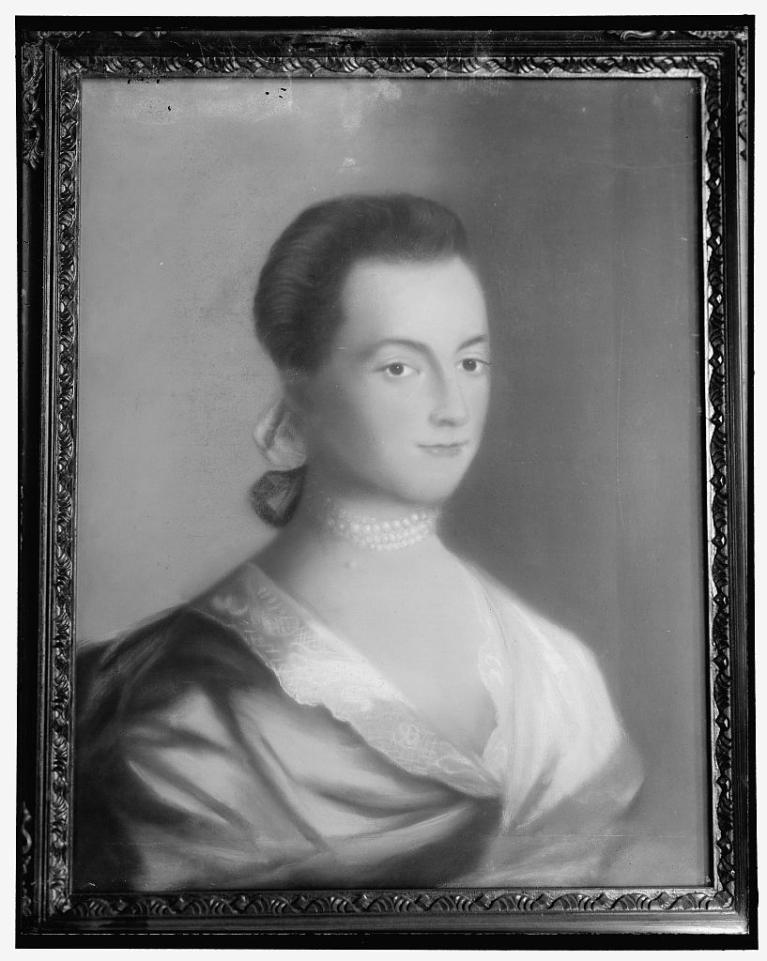First Lady, Advisor, Writer
by Katie Woods, Digital Public Historian
Through her diligent letter writing, Abigail Adams provided a remarkable account of her life as a witness to the Revolutionary War and trusted advisor to one of the founding statesmen and second president of the United States. Born on November 22, 1744 (November 11 by the Old Style Julian calendar), Abigail Smith grew up in a respected family in Weymouth. Her father, Reverend William Smith, served as a Congregational minister and her mother, Elizabeth Quincy Smith, came from the well-known Quincy family of Braintree.
Our House has been upon this alarm in the same Scene of confusion that it was upon the first—Soldiers comeing in for lodging, for Breakfast, for Supper, for Drink &c. &c. Sometimes refugees from Boston tierd and fatigued, seek an assilum for a Day or Night, a week—you can hardly imagine how we live.
–Abigail Adams to John Adams, giving an account of life in Braintree during the Revolutionary era, May 24, 1775
Similar to most girls at the time, Abigail did not receive a formal education. However, she developed a keen interest in reading. Abigail became well-read in Shakespeare, philosophy, theology, and ancient history. She found that a young lawyer named John Adams shared this intellectual curiosity. John and Abigail began courting in 1762. They married on October 25, 1764, starting a true companionship that lasted over fifty years.
In their young married life, John and Abigail Adams moved between the small home in Braintree John had inherited and a home in Boston, closer to his law office. John had a successful law career and became a traveling circuit judge, often leaving Abigail at home to run the house and family finances. From 1765-1772, Abigail birthed five children: Abigail (‘Nabby’), John Quincy, Susanna (died as a baby), Charles, and Thomas Boylston. She later had a stillborn daughter in 1777.
Both Abigail and John were deeply invested in the Revolutionary cause. In 1774, John was elected as a delegate to the Continental Congress in Philadelphia, which meant long stretches away from home. Abigail stepped into the role as the head of household: taking care of and educating the children; managing the house and farm; supervising tenants and workhands; and investing in real estate (in her husband’s name). Likely due to Abigail’s responsible management, entrepreneurship, and ingenuity, the Adamses avoided financial ruin during the turbulent time of the Revolution.
Since they spent many months and years of their marriage apart, Abigail and John nurtured a lifelong correspondence. She provided updates on the children and household, as well as the happenings of the Revolution in the Boston-area. She also offered her thoughts on what the new nation should look like. In September 1774, Abigail voiced her dissent for slavery, saying:
I wish most sincerely there was not a Slave in the province. It allways appeard a most iniquitious Scheme to me—fight ourselfs for what we are daily robbing and plundering from those who have as good a right to freedom as we have. You know my mind upon this Subject.”
Perhaps Abigail Adams is most known for her declaration in favor of women’s rights in what would be the United States, writing to John in 1776 to “Remember the Ladies.”
…by the way in the new Code of Laws which I suppose it will be necessary for you to make I desire you would Remember the Ladies, and be more generous and favourable to them than your ancestors. Do not put such unlimited power into the hands of the Husbands. Remember all Men would be tyrants if they could. If perticuliar care and attention is not paid to the Laidies we are determined to foment a Rebelion, and will not hold ourselves bound by any Laws in which we have no voice, or Representation."
–Abigail Adams to John Adams, March 31, 1776.
With war still raging, John Adams left on diplomatic assignment to France in 1778, bringing John Quincy along. John and Abigail had decided it was too dangerous for both of the couple to travel across the Atlantic, lest they be captured by a British ship. This resulted in their longest separation, with John only briefly returning to rest and write the Massachusetts Constitution. Abigail continued overseeing the household.
Abigail eventually joined John in Paris in 1784, bringing their daughter Abigail (‘Nabby’). They lived in Paris for a year before moving to England when John was appointed the first US Minister to Great Britain. Abigail adapted herself to European court life and hosted parties and dinners. In 1788, they returned to their new estate, “Peacefield,” in Braintree, later called “Quincy.”
The couple did not have long at Peacefield, for in 1789, John Adams became the first Vice President of the United States, and in 1797 the second President of the United States. Due to poor health, Abigail split her time between Quincy and the changing capitals in New York, Philadelphia, and eventually Washington DC. Nevertheless, whenever at the capital, she took on the hostess duties, solidifying this aspect of the First Lady’s role. She also continued to be a constant advisor to her husband on political affairs. Some critics and newspapers believed Abigail had so much influence over her husband that they called her “Mrs. President.” Due to her role as both hostess and advisor, later First Ladies would look to Adams as a model as they defined their own role in the White House.
Suffering the loss of both their son, Charles, and the presidential election in 1800, Abigail and John retired to Quincy in 1801. Abigail kept herself busy by taking care of extended family and investing energy in her son John Quincy’s political career. Adams lived to see John Quincy’s postings as US Senator, minister to Prussia and then Russia, and Secretary of State. She did not live to see him become the sixth President of the United States, giving her the title as the first woman to be the wife of one US president and the mother of another.
After a fruitful life, Abigail Adams died on October 28, 1818 of typhoid fever. Thanks to her letters, the words and views of Abigail Adams have remained alive for centuries. She continues to be remembered in public spaces, including statues at the Boston Women’s Memorial and on Hancock-Adams Common in downtown Quincy.
Additional Resources
Adams Family Papers: An Electronic Archive. Massachusetts Historical Society. 2024.
Founders Online. National Archives and Records Administration. Accessed January 2024.
Herz, Mark. “Quincy to unveil new Abigail Adams statue, honoring an American ‘founding mother.’” GBH. November 4, 2022. Accessed January 2024.
Bibliography
“Abigail Adams (1744-1818).” Adams National Historical Park, National Park Service. April 30, 2015.
“Abigail Adams.” Massachusetts Historical Society. Accessed December 2023.
“Abigail Adams.” In James, Edward T., Janet Wilson James, Paul S. Boyer, eds. Notable American Women: 1607-1950, A Biographical Dictionary, Volume 1. Cambridge: Belknap Press, 1971. pp. 6-9.
“Abigail Adams to John Adams, 24 May 1775.” Founders Online, National Archives. [Original source: The Adams Papers, Adams Family Correspondence, vol. 1, December 1761 – May 1776, ed. Lyman H. Butterfield. Cambridge, MA: Harvard University Press, 1963, pp. 204–206.]
“Abigail Adams to John Adams, 22 September 1774.” Founders Online, National Archives. [Original source: The Adams Papers, Adams Family Correspondence, vol. 1, December 1761 – May 1776, ed. Lyman H. Butterfield. Cambridge, MA: Harvard University Press, 1963, pp. 161–162.]
“Abigail Adams to John Adams, 31 March 1776.” Founders Online, National Archives. [Original source: The Adams Papers, Adams Family Correspondence, vol. 1, December 1761 – May 1776, ed. Lyman H. Butterfield. Cambridge, MA: Harvard University Press, 1963, pp. 369–371.]
“Abigail Smith Adams.” The White House. Accessed December 2023.
Akers, Charles W. Abigail Adams: An American Woman. Boston: Little, Brown & Company, 1980.
“Biography: Abigail Adams.” PBS. Accessed December 2023.
Black, Allida. “Abigail Adams.” In The First Ladies of the United States of America. The White House Historical Association. 2009.
Michals, Debra. “Abigail Adams.” National Women’s History Museum. 2015.
Miller, Elizabeth. “Abigail Adams.” George Washington’s Mount Vernon. Accessed December 2023.
Roberts, Cokie. Founding Mothers: The Women Who Raised Our Nation. New York: HarperCollins Publishers Inc., 2004.

